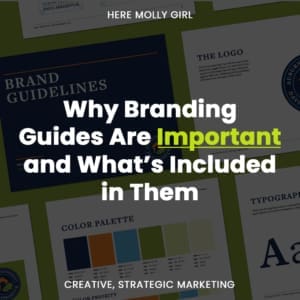The Blueprint of Success: Why Branding Guides Matter and What’s Included

“Oh, I don’t need that.”
We hear this all the time when discussing our logo design process with a client. When we get to the part about creating a branding guide, most clients don’t think they need one. They think branding guides are only useful for huge corporations with thousands of people.
But the truth is, even a one-person business can benefit from a branding guide.
Establishing a strong and consistent brand identity is paramount to success. It’s why we develop one for every logo project we undertake.
Why Branding Guides Matter
1. Consistency Across Channels
A branding guide ensures that your brand message, visuals, and tone remain consistent across all marketing channels, fostering brand recognition and trust.
2. Cohesive Brand Image
By providing a comprehensive overview of your brand elements, a branding guide helps create a cohesive and unified brand image that resonates with your target audience.
3. Efficient Communication
A branding guide serves as a reference point for internal and external stakeholders, streamlining communication and reducing the risk of brand misrepresentation.
4. Guidance for Creativity
While maintaining consistency, a branding guide also provides creative teams with the freedom to explore within defined brand parameters, encouraging innovation. Even amateur design platforms, such as Canva, allow users to upload and utilize branding guides in the design process.
5. Differentiation in the Market
A well-defined brand stands out in a crowded market. A branding guide helps articulate what sets your brand apart and why consumers should choose you.
What’s Included in Branding Guides
While there are different levels of branding guides – from basic to comprehensive – most branding guides have several things in common:
1. Logo Usage Guidelines
Specifies how the logo should be used, including color variations, size proportions, and any clear space requirements to maintain visual integrity.
2. Color Palette
Defines the primary and secondary colors that represent your brand, ensuring a consistent color scheme across all materials.
3. Typography Guidelines
Outlines the fonts used in your branding, including details on headline fonts, body text fonts, and any specific styling considerations.
4. Visual Elements
Details the imagery, graphics, and other visual elements that contribute to your brand’s visual identity, maintaining a cohesive look and feel.
Enhanced branding guides may also include:
1. Brand Mission and Values
Clearly articulate the purpose and values that guide your brand, creating a foundation for all branding efforts.
2. Tone of Voice
Outline the preferred tone and style of communication, ensuring a consistent voice in all written content, from marketing materials to social media posts.
3. Brand Personality
Describe the overall personality of your brand, helping to guide creative decisions and aligning with your target audience’s preferences.
4. Usage Guidelines for Brand Assets
Provide guidelines on how brand assets, such as images and graphics, should be used to maintain consistency across various platforms.
5. Preferred Verbiage
Certain industries benefit from jargon definitions and preferred verbiage when dealing with customers.
Remember: a branding guide is not just a document; it’s the foundation upon which your brand’s success is built. At Here Molly Girl, we understand the power of a well-crafted brand identity, and create unique branding guides for each of our clients. By investing in a comprehensive branding guide, businesses can navigate the competitive landscape with confidence, ensuring that their brand resonates authentically with their audience across all touchpoints.



